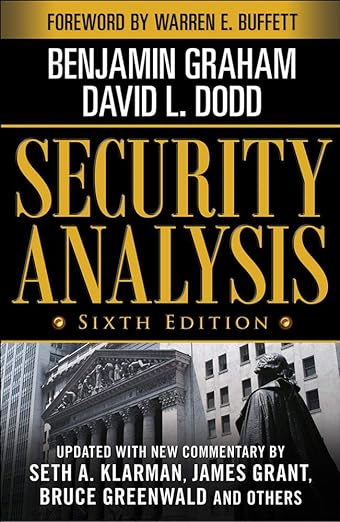Overview : Security Analysis by Benjamin Graham and David Dodd
-
Book Title: Security Analysis
-
Author: Benjamin Graham and David Dodd
-
Publication Date:1934 (first edition)
-
Rating: 5
-
price: $23.09
-
Pages: 725
About the Author
Benjamin Graham, often hailed as the father of value investing, and David Dodd, his collaborator and fellow Columbia Business School professor, combined their expertise to create this comprehensive guide to security evaluation.
Introduction Security Analysis By Benjamin Graham's Book
In the realm of financial literature, few works have left as indelible a mark as "Security Analysis" by Benjamin Graham and David Dodd. First published in 1934, this seminal text has guided generations of investors through the intricacies of value investing. As we navigate today's complex financial landscape, the principles outlined in this book remain as relevant as ever.
Security Analysis Book Summary
At its core, "Security Analysis" provides a framework for evaluating securities based on their intrinsic value rather than market sentiment. The authors advocate for a disciplined approach to investing, emphasizing thorough research and a margin of safety to mitigate risk.
"An investment operation is one which, upon thorough analysis, promises safety of principal and an adequate return. Operations not meeting these requirements are speculative." - Benjamin Graham
This quote encapsulates the book's fundamental philosophy, distinguishing between investment and speculation—a distinction that remains crucial in today's fast-paced markets.
Analysis of Themes
Intrinsic Value
Graham and Dodd's concept of intrinsic value forms the bedrock of value investing. By meticulously analyzing financial statements, investors can determine a security's true worth, independent of its market price. This approach helps identify undervalued opportunities and avoid overpriced assets.
Margin of Safety
The margin of safety principle encourages investors to buy securities only when they are trading significantly below their intrinsic value. This buffer protects against errors in judgment and unforeseen market events, a strategy that has proven effective across various market cycles.
Fundamental Analysis
The book provides a comprehensive guide to analyzing various securities, including bonds, preferred stocks, and common stocks. It delves into the nuances of financial statements, teaching readers how to interpret balance sheets, income statements, and cash flow statements effectively.
Writing Style
While "Security Analysis" is renowned for its depth and rigor, it's important to note that the writing style can be dense and technical. The authors prioritize precision over accessibility, which may pose a challenge for novice investors. However, for those willing to invest the time, the book offers unparalleled insights into security evaluation.
Security Analysis Book Strengths and Weaknesses
Strengths:
- Comprehensive coverage of security analysis techniques
- Timeless principles applicable across market conditions
- Emphasis on risk management through the margin of safety concept
- Detailed examples and case studies
Weaknesses:
- Complex language may be challenging for beginners
- Some examples and regulations referenced are outdated
- Limited coverage of modern financial instruments and market dynamics
Security Analysis Related Books
While "Security Analysis" laid the foundation for value investing, it's worth comparing it to other influential works in the field:
- "The Intelligent Investor" by Benjamin Graham: A more accessible version of Graham's philosophy, aimed at individual investors.
- Common Stocks and Uncommon Profits" by Philip Fisher: Focuses more on qualitative factors and growth investing.
- One Up On Wall Street" by Peter Lynch: Offers a more modern take on stock picking, emphasizing the importance of understanding the business behind the stock.
Each of these books complements "Security Analysis," offering different perspectives on investment strategies.
Relevance in Today's Market
Despite being written nearly a century ago, the principles in "Security Analysis" remain highly relevant in today's market. In an era of algorithmic trading, cryptocurrencies, and complex derivatives, the book's emphasis on fundamental analysis provides a grounding influence for investors. The recent market volatility, exemplified by events like the GameStop short squeeze and the crypto market fluctuations, underscores the importance of understanding intrinsic value and maintaining a margin of safety. As personal finance becomes increasingly complex, the book's teachings on risk management and thorough analysis are more crucial than ever.
Highlights from Security Analysis by Benjamin Graham and David Dodd
Intrinsic Value: Emphasizes valuing stocks based on their intrinsic worth, not market price, to determine true investment potential.
Margin of Safety: Advocates for a margin of safety in investments to reduce risk and account for market unpredictability.
Analyzing Financial Statements: Detailed analysis of balance sheets, income statements, and cash flows is crucial for understanding a company's financial health.
Investment vs. Speculation: Stresses distinguishing between disciplined investing and speculative, high-risk behavior.
Long-Term Perspective: Focuses on sustained value and long-term gains, not short-term market trends.
Qualitative and Quantitative Factors: Considers both measurable data and qualitative elements in making sound investment choices.
Conclusion
"Security Analysis" stands as a testament to the enduring principles of value investing. While the financial landscape has evolved dramatically since its publication, the core tenets of thorough research, intrinsic value, and margin of safety remain invaluable tools for any serious investor. For those looking to deepen their understanding of financial markets and develop a disciplined approach to investing, "Security Analysis" is an indispensable resource. Its teachings can help investors navigate market trends, evaluate diverse asset classes (including modern ones like cryptocurrencies), and make informed decisions in their personal finance journey.





